Honest review of the drive OCZ Trion 150
Not so long ago, the OCZ blog had a review of the Trion 100 drive , and today I had an updated version of it - the Trion 150. As before, the drive is positioned in the public sector with all its attendants: there are not enough stars from the sky, ease of manufacture, low price. In the Moscow retail, you can buy the 150th for 5500, 10500 and 20500 rubles (256, 480 and 960 GB, respectively). What does the user get in exchange for hard earned money? Let's look at all the details.
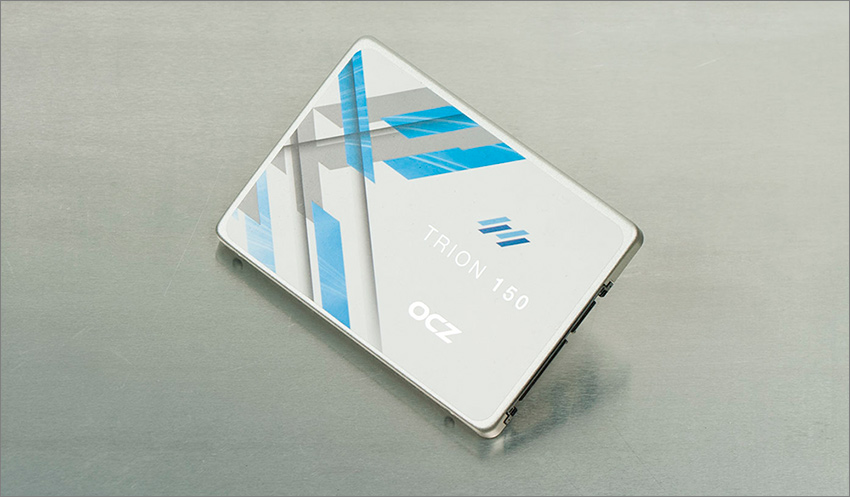
A receives on the issue of a small cardboard box, which keeps its shape thanks to a polypropylene insert; the packaging is completely identical to that of the Trion 100, except that the colors are darker.

Iron SSD case, thickness 7 mm, on the front side (it’s the top) sticker indicating the series:
')

The exact model can be found in the label below.

From the inscriptions it follows that in front of us is a 480 GB solid-state drive, SATA III interface, form factor 2.5 ". A total of four volumes: 120, 240, 480 and 960 GB.
Body halves hold together four latches on the perimeter. Inside is a printed circuit board with electronics:

Immediately interesting to compare with the hundredth series:

As you can see, the board has grown significantly in size, the NAND Flash chips have become larger, the packaging has changed from BGA to TSOP. I suspect that far from the last motivation for changing the type of case was the cheapness of TSOP production relative to BGA.
After removing the PCB from the case, you can admire the controller

Hmm. A thermal rubber has stuck to the controller, which transfers the heat generated by the microcircuit to the case, and it is not possible to read the marking. But you can clearly see four more Flash memory chips and one buffer. Immediately photo board predecessor:

I note that the difference in the volume of drives (“hundredth” of 240 GB, one hundredth - 480) in this case does not affect the appearance, since the PCB of the Trion 100 of 480 GB looks exactly the same.
The controller on the fiftieth Trion is completely analogous to its predecessor:

As described in the Trion 100, the real name of the controller is Phison PS3110-S10.
Cache on the board 512 MB, type - DDR3:
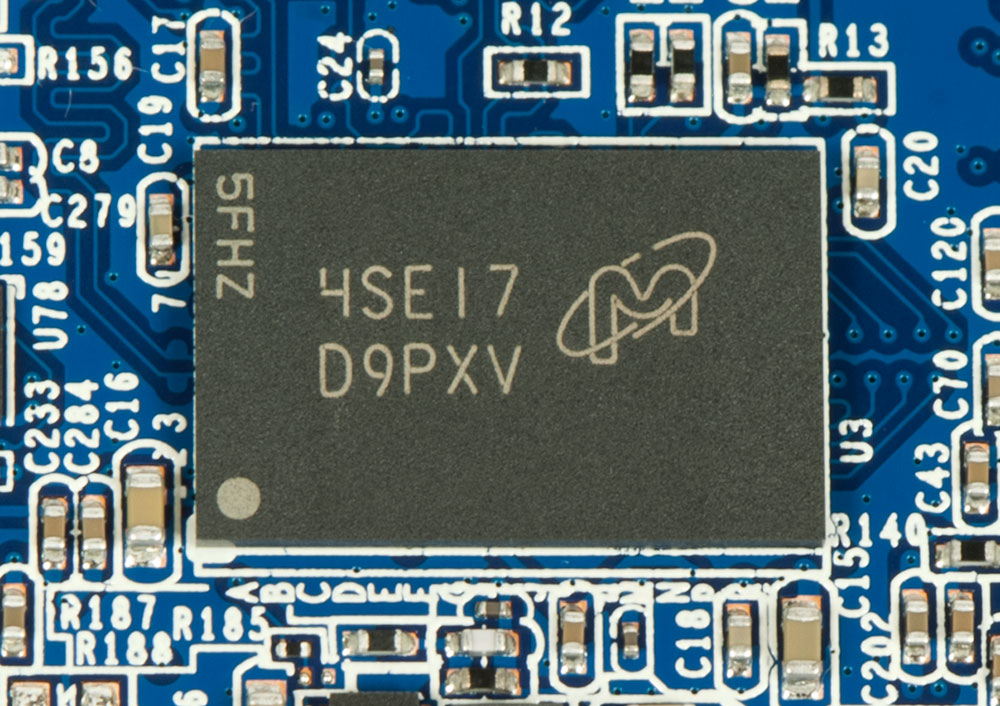
It turns out that the only visible difference is in the NAND memory, which is in the Trion 100 TLC and performed on the 19 nm process technology, and in the Trion 150 the same TLC, but already manufactured on the 15 nm process technology. Inside, according to the manufacturer, there is still an updated controller firmware.

A more subtle technical process, as is well known, brings not only improved performance (smaller dimensions and heat generation at the same volume), but also problems with mass production. Intel, while mastering the 14nm process technology, worked a lot before the scrap rate settled down to acceptable values. At Toshiba, as far as is known from open sources, there were no problems with fifteen nanometers. There are no statistics on the TLC memory created by Toshiba on this technical process yet, since the Trion 150 is currently the only drive with such a memory (if we talk about the retail segment).
Crystal Disk Info revealed that the drive was virgin: it was turned on only once, the total running time was 0 hours.
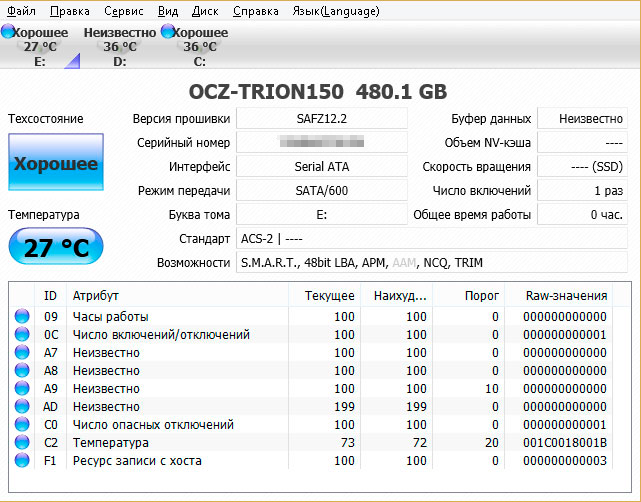
The proprietary SSD utility Guru gives a little more information about the drive:
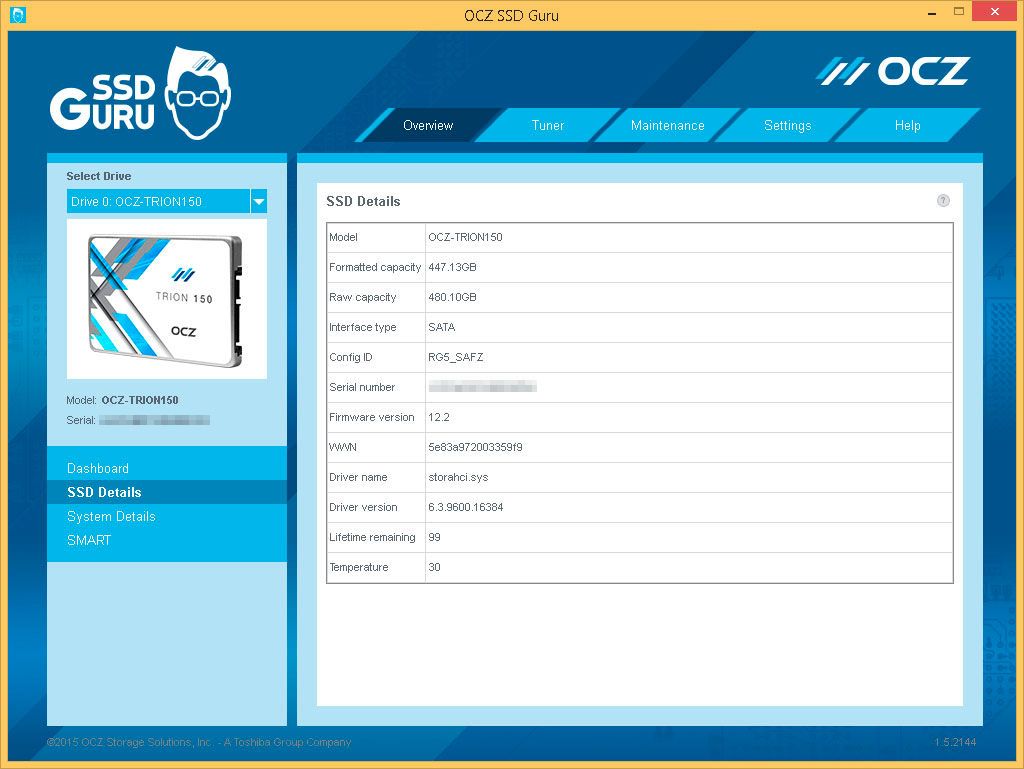


From it, you can learn that the volume of the reserve zone (Over-Provisioning), which is available for changing to the user, is by default set to 8 GB, while in the Trion 100 the slider stood at 0.
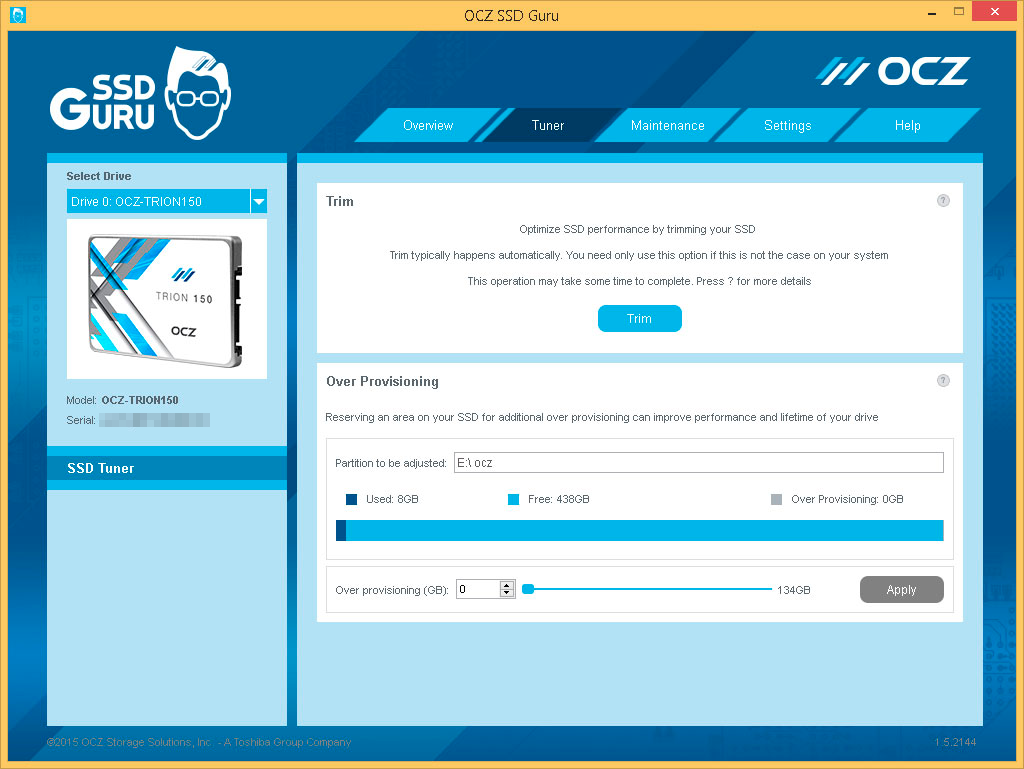

Let me remind you that Over-Provisioning technology is designed to increase the lifetime of the disk and help the controller in working with information. It also improves random read and write performance. Minus - a certain percentage of the total volume of the drive becomes unavailable to the user for data placement. In the case of the Trion 150, it accounts for 32 GB of the total FLASH-chips (512 GB), or just under 6.3%. Together with 8 GB, the result is 40, which is 7.8%. Usually, from 5 to 10 percent of the total volume for home use and up to a quarter of the total volume in the industrial and server sectors are allocated for such needs.
For convenience, all the basic characteristics of the test SSD are summarized in the table:
Check drive performance was carried out on a test stand of the following configuration:
Compared to the config in the Trion 100 material, the motherboard and RAM have changed (4 strips of 4 GB instead of two of 8 GB each), but I don’t think that this can affect the results: the chipset on the motherboards is the same, the speed of working with memory (frequency, timings) are also the same. So, the results of the Trion 150 itself will be supplemented by the indicators of all SSDs from the “100th” material, as well as the Plextor M5P (a model of two years ago that is quite well-known and respected for its speed indicators). Total already five blocks of numbers, and in the traditional version (a series of screenshots) to compare them is problematic. Therefore, the main indicators are shown in the form of graphs, and for the curious, the standard feed in the form of screenshots is preserved. Yes - the Windows 8.1 operating system is clean, “processed” by the SSD Tweaker utility.
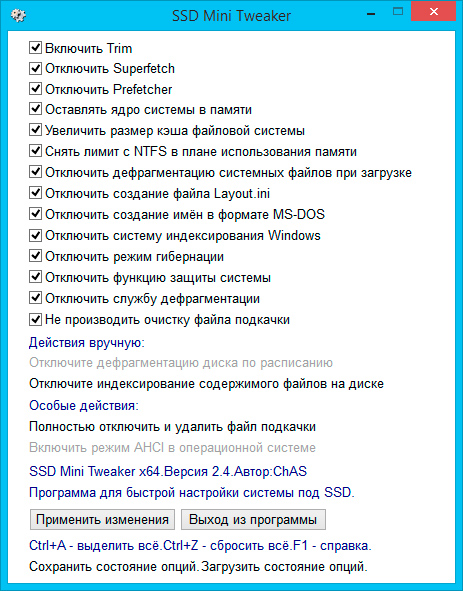
The results for the Trion 150 are predictable: better than the Trion 100, and not everywhere lagging behind other mid-level models.
Sequential read / write from Crystal Disk Mark:
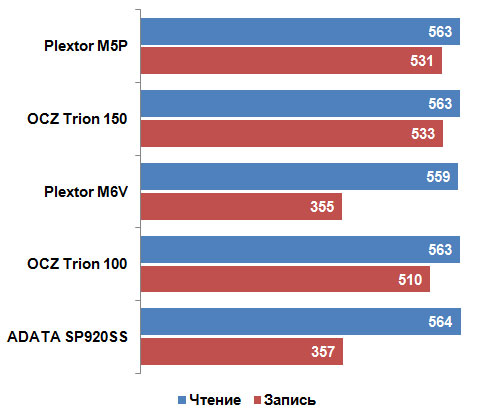
Reading / writing in blocks of 4 KB (Crystal Disk Mark):
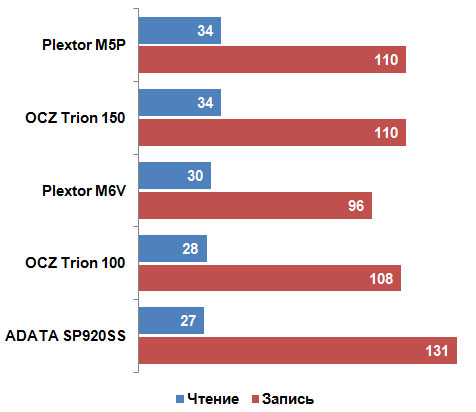
Built-in AS SSD benchmark with emulation of recording large blocks of data (ISO), medium (Game) and small (Program):

All results in a couple of screenshots (clickable):
PC mark 8, storage test:

In sequential reading and writing, the drive is good, and in other “disciplines” it shows itself to be great. It is important to remember that this data is removed from the new SSD, and over time the speed indicators will be lower. But even with this factor in mind, the Trion 150 looks like an interesting purchase.
As for comparison with the Trion 100, the fiftieth model is definitely better, and all other things being equal (price, for example) it is worth taking the last one. Looking back at the experience of other companies, one may be afraid of the “unsuccessful” series (which, by the way, happened at the “old” OCZ), and also remember the memory that was not processed in 15 nm TLC, its relatively low resource. But there's nothing to be done: either buy a new one at your own peril, minding about the warranty period (in this case, OCZ has a completely cool service ShieldPlus , about which you have already written in the blog), or wait a couple months for reviews to accumulate, and then make a decision.
Take care of your data!

A receives on the issue of a small cardboard box, which keeps its shape thanks to a polypropylene insert; the packaging is completely identical to that of the Trion 100, except that the colors are darker.

Iron SSD case, thickness 7 mm, on the front side (it’s the top) sticker indicating the series:
')

The exact model can be found in the label below.

From the inscriptions it follows that in front of us is a 480 GB solid-state drive, SATA III interface, form factor 2.5 ". A total of four volumes: 120, 240, 480 and 960 GB.
Body halves hold together four latches on the perimeter. Inside is a printed circuit board with electronics:

Immediately interesting to compare with the hundredth series:

As you can see, the board has grown significantly in size, the NAND Flash chips have become larger, the packaging has changed from BGA to TSOP. I suspect that far from the last motivation for changing the type of case was the cheapness of TSOP production relative to BGA.
After removing the PCB from the case, you can admire the controller

Hmm. A thermal rubber has stuck to the controller, which transfers the heat generated by the microcircuit to the case, and it is not possible to read the marking. But you can clearly see four more Flash memory chips and one buffer. Immediately photo board predecessor:

I note that the difference in the volume of drives (“hundredth” of 240 GB, one hundredth - 480) in this case does not affect the appearance, since the PCB of the Trion 100 of 480 GB looks exactly the same.
The controller on the fiftieth Trion is completely analogous to its predecessor:

As described in the Trion 100, the real name of the controller is Phison PS3110-S10.
Cache on the board 512 MB, type - DDR3:

It turns out that the only visible difference is in the NAND memory, which is in the Trion 100 TLC and performed on the 19 nm process technology, and in the Trion 150 the same TLC, but already manufactured on the 15 nm process technology. Inside, according to the manufacturer, there is still an updated controller firmware.

A more subtle technical process, as is well known, brings not only improved performance (smaller dimensions and heat generation at the same volume), but also problems with mass production. Intel, while mastering the 14nm process technology, worked a lot before the scrap rate settled down to acceptable values. At Toshiba, as far as is known from open sources, there were no problems with fifteen nanometers. There are no statistics on the TLC memory created by Toshiba on this technical process yet, since the Trion 150 is currently the only drive with such a memory (if we talk about the retail segment).
Crystal Disk Info revealed that the drive was virgin: it was turned on only once, the total running time was 0 hours.

The proprietary SSD utility Guru gives a little more information about the drive:



From it, you can learn that the volume of the reserve zone (Over-Provisioning), which is available for changing to the user, is by default set to 8 GB, while in the Trion 100 the slider stood at 0.


Let me remind you that Over-Provisioning technology is designed to increase the lifetime of the disk and help the controller in working with information. It also improves random read and write performance. Minus - a certain percentage of the total volume of the drive becomes unavailable to the user for data placement. In the case of the Trion 150, it accounts for 32 GB of the total FLASH-chips (512 GB), or just under 6.3%. Together with 8 GB, the result is 40, which is 7.8%. Usually, from 5 to 10 percent of the total volume for home use and up to a quarter of the total volume in the industrial and server sectors are allocated for such needs.
For convenience, all the basic characteristics of the test SSD are summarized in the table:
| Model | TRN150-25SAT3-480G |
| Declared volume, GB | 480 |
| Form factor | 2.5 " |
| Interface | SATA III 6Gb / s |
| User accessible volume, GB | 446 |
| Buffer size, MB | 512 |
| NAND chips | Toshiba 15nm TLC |
| Controller | Toshiba TC58NC1000GSB |
| Declared max. read speed, MB / s | 550 |
| Declared max. write speed, MB / s | 530 |
| Power consumption, work / inaction, W | 0.83 / 4.8 |
| Time between failures, million hours | 1.5 |
| Dimensions, mm | 100 x 70 x 7 |
| Weight, g | 48 |
| CPU | Intel Core i7-6700K |
| Motherboard | ASUS Z170 Pro Gaming |
| RAM | 4x 4 GB DDR4-2133 |
| Drive (system) | SanDisk SSD 240 GB |
| Video card | ASUS ARES II |
| Power Supply | Enermax Triathlor 550 W |

The results for the Trion 150 are predictable: better than the Trion 100, and not everywhere lagging behind other mid-level models.
Sequential read / write from Crystal Disk Mark:

Reading / writing in blocks of 4 KB (Crystal Disk Mark):

Built-in AS SSD benchmark with emulation of recording large blocks of data (ISO), medium (Game) and small (Program):

All results in a couple of screenshots (clickable):
PC mark 8, storage test:

In sequential reading and writing, the drive is good, and in other “disciplines” it shows itself to be great. It is important to remember that this data is removed from the new SSD, and over time the speed indicators will be lower. But even with this factor in mind, the Trion 150 looks like an interesting purchase.
As for comparison with the Trion 100, the fiftieth model is definitely better, and all other things being equal (price, for example) it is worth taking the last one. Looking back at the experience of other companies, one may be afraid of the “unsuccessful” series (which, by the way, happened at the “old” OCZ), and also remember the memory that was not processed in 15 nm TLC, its relatively low resource. But there's nothing to be done: either buy a new one at your own peril, minding about the warranty period (in this case, OCZ has a completely cool service ShieldPlus , about which you have already written in the blog), or wait a couple months for reviews to accumulate, and then make a decision.
Take care of your data!
Source: https://habr.com/ru/post/391965/
All Articles

